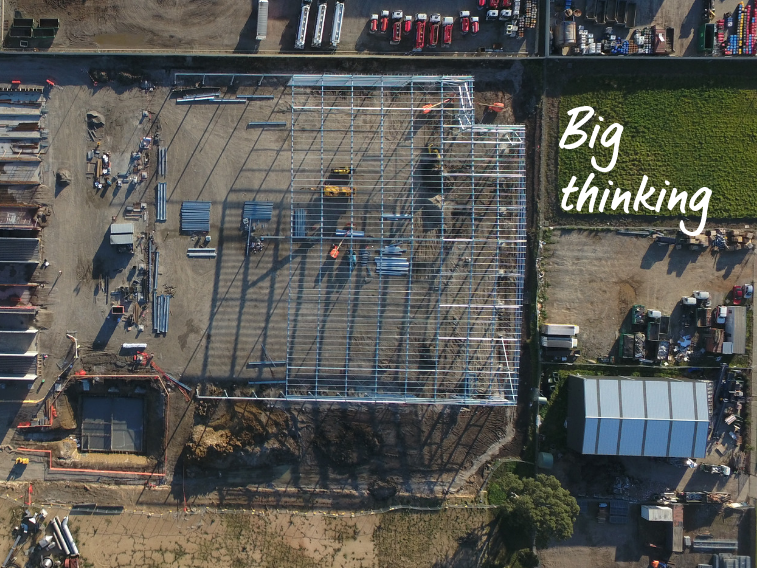We expect NAB’s Non-rural Commodity Price Index to fall by 4.9% in Q2


Insight
As more local governments around Australia seek new ways to treat food waste, councils in southeast Melbourne have met the challenge of bulging landfill and increasing greenhouse emissions by composting household organic waste on an industrial scale.

For the first time, residents in eight council areas in Melbourne’s southeast are now able to add food scraps to their garden waste instead of putting it into their bins, helping to address the growing problem of food scraps adding to landfill.
With financing arranged by NAB, the new South Eastern Organics Processing Facility will take up to 120,000 tonnes of food and garden waste a year and turn it into 50,000 tonnes of usable compost.
As the food waste isn’t going to landfill where it would ferment and produce methane, the processing facility will reduce greenhouse emissions by the same amount as taking nearly 14,000 cars off the road.
Carlos Gros, a Director of Sacyr Environment Australia, a subsidiary of Spanish construction giant Sacyr S.A., explains the composting process at the facility will be the same process that happens naturally but sped up through the circulation of water and oxygen through the waste. “We can do it in less time and on a bigger scale,” he says.
The oxygen will ensure the material doesn’t ferment enough to produce any greenhouse gases, as it would in anaerobic – or oxygen-free – decomposition that takes place in sealed landfills.
The facility produces high quality fertiliser in six to eight weeks which can be either used by the councils or sold for profit.
Gros says that as a general principle, anything that can be reused or have a new use shouldn’t go into landfill.
Sacyr will operate the facility for 15 years with the option of a five-year extension.
Overseen by Victoria’s Metropolitan Waste and Resource Recovery Group, the $65 million project was funded with $38 million of debt from the federal government’s Clean Energy Finance Corporation (CEFC).
While the CEFC has funded other waste projects, it’s the first time it has been involved in a standalone organics diversion project.
“This is a landmark transaction for us,” says Mac Irvine, Associate Director at the CEFC. “It’s one we wanted to do both for the benefits of the transaction itself as well as for the broader industry impact and potential.”
Irvine says there’s significant potential to roll out similar projects across Australia, in both capital cities and regional areas.
“There’s still a huge proportion of organic matter that goes to landfill as part of people’s red or black bin. We’re seeing an increasing trend for these types of facilities coming from community pressure as well as industry and political momentum,” he says.
The investment is via project finance – a funding model that hasn’t been widely used by councils in the past.
“It’s important to have different models of investment available to allow new investors and capital to come into the market because the scale of transformation the industry needs to undergo requires a significant amount of capital,” Irvine says.
NAB acted as the financial advisor to Sacyr, providing expertise on the local capital market and raising the debt, and working on due diligence with the CEFC.
While project financing has long been used in the infrastructure space, it’s relatively new in waste processing, says Janet Wong, Director, Financial & Equity Advisory at NAB.
This presented a challenge because there were no precedent transactions for this type of deal in waste for potential lenders to look at. Furthermore, because the loan was being made against the project’s cashflows rather than against a corporate balance sheet, the deal came under closer scrutiny from lenders.
The councils supported the deal with 15-year waste supply contracts and by guaranteeing a minimum amount of waste which helped reduce risk.
“For councils to guarantee a certain amount of waste can be challenging, because you can forecast but not everything always goes to plan,” says Wong. “Getting the right balance of what was the minimum volume guarantee we needed to support the deal was probably the most critical part to unlocking the project finance.”
Wong says NAB and CEFC is supporting a new market in project financing for waste projects and the South East Organics project is an important first step.
“The project finance market in Australia for waste projects is a growing and developing market,” she says. “By having more of these precedent deals, it then allows sponsors as well as advisors and banks to point to examples of where it’s been done, where it’s working and look at those structural elements to then roll out for future deals.”
Speak to a specialist
© National Australia Bank Limited. ABN 12 004 044 937 AFSL and Australian Credit Licence 230686.